
Video Upload Options
Tobacco is the agricultural product of the leaves of plants in the genus Nicotiana. All species of Nicotiana contain the addictive drug nicotine—a stimulant and sedative contained in all parts of the plants except the seeds—which occurs in varying amounts depending on the species and variety cultivated. See types of tobacco and curing of tobacco for more information. The vast majority of commercially available tobacco is derived from the species Nicotiana tabacum, although it is also produced from Nicotiana alata, and to a lesser extent Nicotiana clevelandii, Nicotiana longiflora, and Nicotiana rustica, among others. N. rustica in particular contains much more nicotine than N. tabacum and other species of Nicotiana, and forms the basis of a number of unique tobacco products, including several preparations used in Latin American shamanic ceremonies. Once tobacco has been grown, harvested, cured, and processed, it is used to produce a number of different products. These are most often consumable; however, tobacco and the nicotine derived from it are also used to create pesticides. Tobacco products can generally be divided into two types: smoked tobacco (see tobacco smoking) and smokeless tobacco. An expert in tobacco and tobacco products — especially pipes, pipe tobacco, and cigars—including their procurement and sale, is called a tobacconist. The health effects of tobacco consumption are discussed in health effects of tobacco.
1. Consumable
1.1. Chewing Tobacco
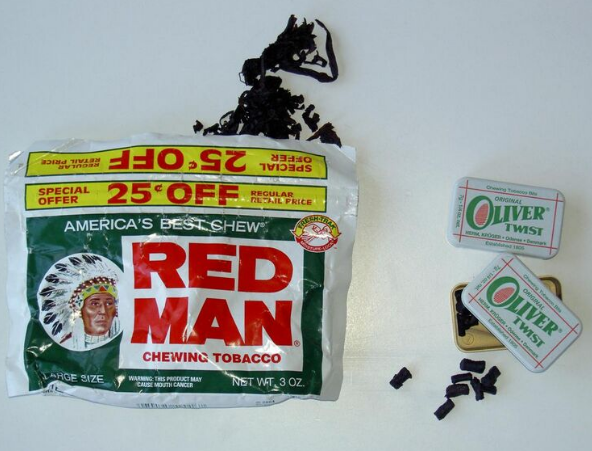
Chewing is one of the oldest methods of consuming tobacco leaves. Native Americans in both North and South America chewed the fresh leaves of the tobacco plant, frequently mixed with lime.
Western chewing tobacco
Modern American-style chewing tobacco (colloquially known as chew or chaw, especially in the American South and Midwest) is produced from cured and often fermented tobacco, usually dampened and mixed with some type of sweetener. (Often molasses.) Twist tobacco may be an exception in this case, as many brands of twist are not sweetened.
In using chewing tobacco—at least types other than tobacco pellets—the consumer usually deposits the tobacco between the cheek and teeth and lightly macerates and sucks the tobacco to allow its juices to flow. Thus when chewing, it is common to spit and discard excess saliva caused by the release of juices from the tobacco, justifying the existence of the spittoon, or cuspidor.
The popularity of American-style chewing tobacco and the associated spittoon reached its height in the American Midwest during the late 19th century; however, as cigarettes became the predominant form of tobacco consumption the spittoon gradually fell into disuse across the United States. While spittoons are often a rarity in modern society, loose leaf chewing tobacco can still be purchased at many convenience stores or from tobacconists throughout the United States and Canada .
Chewing tobacco endemic to the Western world is manufactured in several forms:
Loose leaf
Loose leaf chewing tobacco, also known as scrap, is perhaps the most common contemporary form of American-style chewing tobacco. It consists of cut or shredded strips of tobacco leaf, and is usually sold in sealed pouches or bags lined with foil. Often sweetened, loose leaf chew may have a tacky texture. (Though there are also unflavored or "natural" loose leaf chews. However, these are far less common.) Popular, modern brands of scrap sold in North America include Red Man, Levi Garrett, Jackson's Apple Jack (made by Swisher International), Beech-Nut (formerly made by Lorillard; now Reynolds American), and Stoker's.
Pellets
Pellets or bits consist of tobacco rolled into small pellets. They are often packaged in portable tins. Tobacco pellets are used in the same manner as snus, in that they are placed between the lip and gum, and that spitting is typically unnecessary. It is suggested that the user may periodically chew the pellets lightly in order to release additional juice, flavor, and/or nicotine. Tobacco bits are almost exclusively produced under the Northern European Oliver Twist and Piccanell brands. They are thus—like snus—preponderant in the Scandinavian region.
Plug
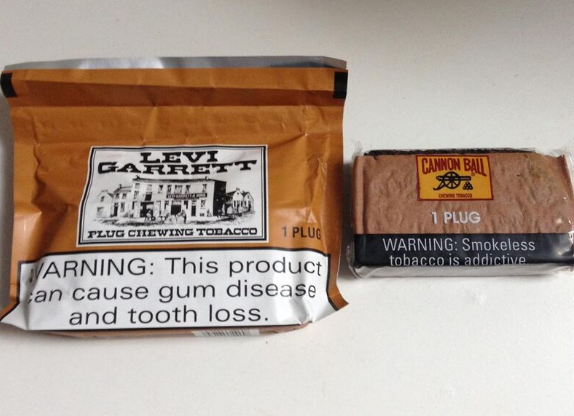
Plug tobacco is made up of tobacco leaves that have been pressed together and bound by some type of sweetener, resulting in a dense, square tobacco mass. (Some compare the look of plug tobacco to a brownie or similar pastry.) One can then bite directly from the mass or slice the tobacco into portions. Some types of plug may either be chewed or smoked in a tobacco pipe, and some are exclusive to one method of consumption or the other.
Plug tobacco was once a much more common product, available to many American consumers during the 19th century. Two tobacco companies that historically manufactured plug are Liggett and Lorillard. (The latter was known for its Climax brand of plug.)
Modern brands of chewing plug include "rustic" and simple packaging, as is the case with popular plugs like Apple Sun Cured, Brown's Mule, Cannon Ball, Cup, Days Work, and Days O Work. Some well-known loose leaf chewing tobacco brands, such as Red Man and Levi Garrett, have their own versions of plug tobacco, as well.
Twist
Twist or rope tobacco is made up of rope-like strands of tobacco that have been twisted together and cured in that position, afterwards being cut. Some types of twist may either be chewed or smoked in a tobacco pipe, and some are exclusive to one method or the other.
Unlike other types of chewing tobacco, twist tobacco isn't always a sweetened product, and may be devoid of molasses.
Indian chewing tobacco
Different types of chewing tobacco are endemic to the Indian subcontinent.
Gutkha
Gutkha (also transliterated gutka) is a chewing tobacco product popular in India and surrounding regions.
It is a mixture of betel nuts, tobacco, paraffin wax, catechu, and slaked lime.
It is similar to mava.
Mava
Mava (also transliterated mawa) is a chewing tobacco product popular in Gujarat, India, made with a mixture of betel nut, calcium carbonate and flavoured tobacco. It is also known faki or masala.
It is similar to gutkha.
1.2. Cigars
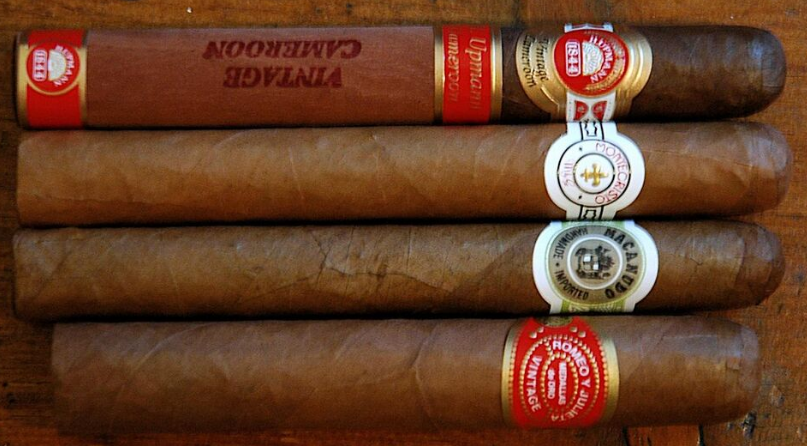
A cigar is a tightly rolled bundle of dried and fermented tobacco which is ignited so that its smoke may be drawn into the smoker's mouth and expelled; thus the cigar is generally "puffed on" (like a tobacco pipe) as opposed to being inhaled from (as is the case with cigarettes). The cigar is one of the oldest methods of preparing tobacco for consumption, some of the first cigars being introduced to Europeans as rolls of tobacco smoked by the Taíno of 15th century Cuba.
There are numerous varieties of cigar, differentiated by their respective size, shape, color, and composition. Some products developed from the cigar are, however, markedly different from the traditional product. (Cigarillos, blunts, and little cigars, for instance.) Cigarettes may be the most notable example of this deviation, although they do, in a sense, represent a category of their own.
Tobacciana associated with cigars include cigar tubes, cigar boxes, cigar holders (also known as "cigar mouthpieces"; cf. cigarette holder), cigar cutters (including cigar scissors or shears), cigar cases, and humidors.
Blunts
Blunts are wide, somewhat stubby versions of cigars. Most, if not all, are machine-made "domestic cigars" created from homogenized or reconstituted tobacco. They are usually inexpensive, and only lightly fermented.
Cigarillos
Cigarillos are long, thin cigars, somewhat larger than cigarettes but smaller than regular cigars. They may be fitted into a cigarillo holder in order to be smoked, though they are most often smoked without such a device. Using a cutting tool in order to prepare a cigarillo is less common than with larger cigars, as they are often open on both ends. Cigarillos may be machine-made, although many hand-made versions do exist; the latter are often produced by premium cigar manufacturers. In modern-day America, machine-made cigarillos can be used as marijuana cigars in a manner similar to machine made-large cigars.
Little cigars
A little cigar is a cigar that is the same size as a cigarette—often featuring a filter—however, it still retains its identity as a cigar because it is wrapped in a tobacco leaf, or more often a paper wrapper made of tobacco pulp, reconstituted tobacco or homogenized tobacco. Flavored little cigars are available on the market as well. Flavored little cigars have been steadily increasing in popularity among cigar smokers. Manufacturers like Prime Time have been offering flavored little cigars since 1993.
Roll-your-own cigars
Several manufacturers have begun producing cigar wraps. Cigar wraps consist of tobacco leaf which can then be used with a tobacco blend to produce a hand-rolled cigar.
1.3. Cigarettes
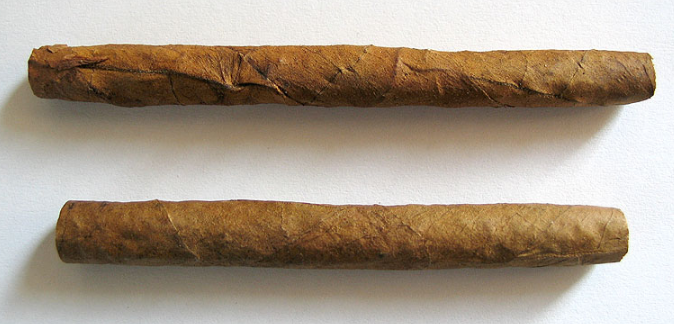
Cigarettes are a product consumed through smoking and manufactured out of cured and finely cut tobacco leaves and reconstituted tobacco, often combined with other additives,[1] then rolled or stuffed into a paper-wrapped cylinder (generally less than 120 mm in length and 10 mm in diameter).
Bidis
Kreteks
Kreteks are cigarettes made with a complex blend of tobacco, cloves and a flavoring 'sauce'.
Roll-Your-Own
Roll-Your-Own (RYO) or hand-rolled cigarettes, are very popular particularly in European countries. These are prepared from loose tobacco, cigarette papers and filters all bought separately. They are usually much cheaper to make.
1.4. Creamy Snuff
Creamy snuff is a tobacco paste, consisting of tobacco, clove oil, glycerin, spearmint, menthol, and camphor, and sold in a toothpaste tube. It is marketed mainly to women in India , and is known by the brand names Dentobac, Tona, Ganesh. It is locally known as "mishri" in some parts of Maharashtra. According to the U.S. NIH-sponsored 2002 Smokeless Tobacco Fact Sheet. The same factsheet also mentions that it is "often used to clean teeth". The manufacturer recommends letting the paste linger in the mouth before rinsing.
1.5. Dipping Tobacco
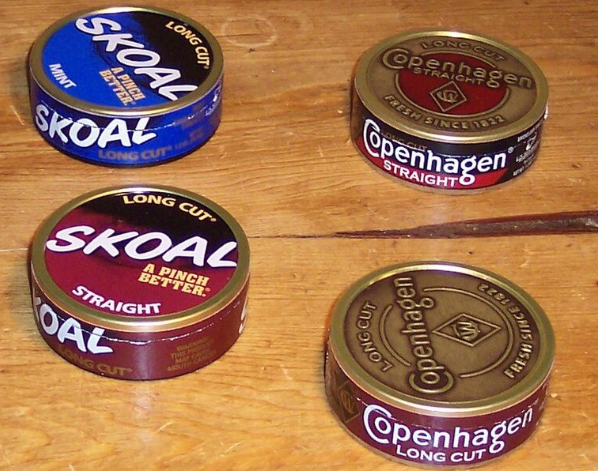
Dipping tobacco, also known as dip, moist snuff (or simply snuff), American moist snuff, or spit tobacco, is a form of smokeless tobacco. (It should also be noted that the term smokeless tobacco itself is a broad one which, while generally referring to all tobacco products which do not require smoking (e.g. nasal snuff, chewing tobacco, snus, etc.), is popularly used to refer specifically to dipping tobacco.) Dip is sometimes also called chew or chaw; because of this, it is commonly confused with chewing tobacco. Because it is sometimes called snuff or moist snuff, it can also be confused with nasal or dry snuff.
Instead of literally chewing on dipping tobacco, as is the case with chewing tobacco, a small clump of dip is "pinched" out of its container and placed between the lower or upper lip and gums. While it is most common to place the tobacco between the lower lip and gums, utilizing the upper lip for this purpose—in a manner more common to snus—is known as an "upper decker".
In modern times, dipping tobacco is usually packaged in metal or plastic tins, sometimes with the addition of fiberboard. Some brands are packaged into "tubs", or deeper hand-held containers.
Dipping tobacco comes in several varieties. Many dipping tobacco producers also manufacture pouches of dipping tobacco, making the habit cleaner and more convenient. The following are standard cut sizes, but some brands can still vary in size.
Cut sizes
Extra long cut
Extra long cuts are the longest cut size. Copenhagen and Grizzly both make an extra long cut natural variety.
Wide cut
Wide cuts have thicker strands than all other cuts of dipping tobacco. Currently, wide cut is only manufactured by Grizzly.
Long cut
Long cuts are easier to manage than fine cuts (a smaller granular sized dip - in regard to ease of grabbing the tobacco and keeping it comfortably in mouth). This is the most common cut of tobacco.
Mid cut
Mid cut sized dipping tobacco is comparable to small granules at about 1 mm cubed. A couple of mid cuts were on the smokeless tobacco market but have since been discontinued.
Fine cut
Fine cut comes in granules slightly larger than sand or coffee grounds.
Snuff
Snuff or simply moist snuff looks similar to dirt or sand in terms of granular size. Extremely small cut.
Pouches
Pouches hold fine cut tobacco in a small teabag-like pouch for convenience. Pouches are typically about the same size, but one brand, Skoal, also offers a smaller pouch called Bandits.
1.6. Dissolvable Tobacco
Dissolvable tobacco is a recent introduction, entering mainstream use in the later half of the 2000s (decade). The product consists of finely-processed tobacco which is developed in such a way as to allow the substance to dissolve on the tongue or in the mouth. Camel tobacco is the major purveyor of dissolvable tobacco products, with three varieties, including strips, sticks and orbs, however companies such as Ariva and Stonewall have also been successful with such manufacturing, marketing compressed tobacco lozenges.
1.7. Dokha
Dokha is a tobacco of Iranian origin mixed with leaves, bark, and herbs. It is traditionally smoked in a midwakh.
1.8. Gutka
Gutka (also spelled gutkha, guttkha, guthka) is a preparation of crushed betel nut, tobacco, and sweet or savory flavorings. It is manufactured in India and exported to a few other countries. A mild stimulant, it is sold across India in small, individual-size packets. It is consumed much like chewing tobacco, and like chewing tobacco it is considered responsible for oral cancer and other severe negative health effects.
Used by millions of adults, it is also marketed to children. Some packaging does not mention tobacco as an ingredient, and some brands are pitched as candies - featuring packaging with children's faces and are brightly colored. Some are chocolate-flavored, and some are marketed as breath fresheners.
1.9. Kizami
Kizami is a tobacco product produced in Japan and intended for smoking in Japanese kiseru pipes.
1.10. Iqmik
Iqmik is an Alaskan smokeless tobacco product used with punk ash. It is most common among natives. Nicotine is freebased with caustic ash and thus iqmik is more addicting and potent than regular chewing tobacco.
1.11. Mu'assel
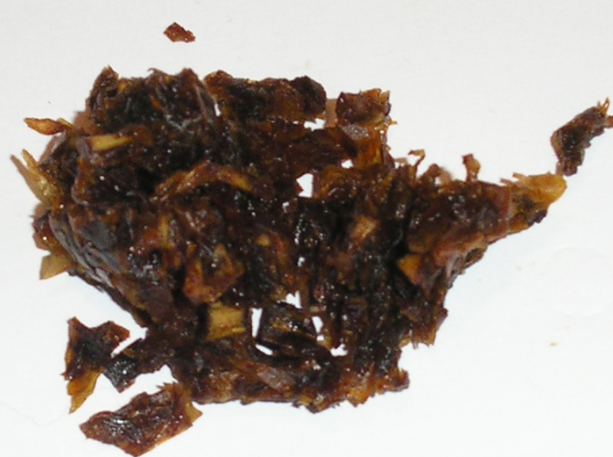
Mu'assel, shisha tobacco, hookah tobacco, or simply shisha is a somewhat moist form of tobacco that is mixed with glycerin and coagulated with molasses or other sticky sweeteners and has been popular in the Middle-East for centuries. It is often smoked with a hookah. Its names include ma'sal (also romanized as the aforementioned mu'assel), tumbâk, and jurâk.
1.12. Naswar
Naswar is a type of smokeless tobacco popular in Afghanistan and surrounding countries. It is moist and powdered, and lime or juniper is added for flavor.
1.13. Snuff
Snuff is a generic term for fine-ground smokeless tobacco products. Originally the term referred only to dry snuff, a fine tan dust popular mainly in the 18th century. In the U.S., this is often called "Scotch Snuff", a folk-etymology derivation of the scorching process used to dry the cured tobacco by the factory. Snuff powder originated in the UK town of Great Harwood and was famously ground in the town's monument prior to local distribution and transport further up north to Scotland.
European (dry) snuff is intended to be shallowly "sniffed" (technically insufflated) into the nose, where nicotine is absorbed through the mucous membranes in the nostrils. Snuff is not deeply "snorted" (such as in the way cocaine is) because snuff shouldn't get past the nose, i.e. into sinuses, throat or lungs. Generally a small portion of dry snuff is either pinched in the fingers or laid out on the wrist of the user, from where it is sniffed.
European snuff comes in several varieties: plain, toast (fine ground and very dry), "medicated" (with menthol, camphor, eucalyptus, etc.), scented, and Schmalzler, a German variety. The major brand names of European snuffs are: Toque Tobacco (UK), Bernards (Germany), Fribourg & Treyer (UK), Gawith (UK), Gawith Hoggarth] (UK), Hedges (UK), Lotzbeck (Germany), McChrystal's (UK), Pöschl (Germany), Toque (UK), and Wilsons of Sharrow (UK).
Although less common, American (dry) snuff also exists, and is typically used orally in a similar manner to moist snuff. It is placed in the lower lip, and is most popular in the South. Brands include: Carhart's CC, Peach Sweet, and Tube Rose, among others.
American (moist) snuff is a term synonymous with dipping tobacco or "dip".
1.14. Snus
Snus is a type of smokeless tobacco originating from and popular in Sweden and other Scandinavian countries. It differs from moist snuff or chewing tobacco in that it is made from steam-cured tobacco leaves, rather than fire-cured ones, and its health effects are markedly different, with epidemiological studies showing lower rates of cancer and other tobacco-related health problems than cigarettes, American "chewing tobacco", Indian gutka or African-type tobacco products. Prominent Swedish brands are Swedish Match, General, Ettan, and Tre Ankare. In many Scandinavian countries, snus comes either in loose powder form, to be pressed into a small ball (called "baking" the snus) by hand or with the use of a special tool, or in small bags (called "portioned snus" form). Both are suitable for placing under one of the lips, most often the upper. Portioned snus is in particular a popular type because it keeps loose tobacco from becoming stuck between the user's teeth; they also produce less spittle when in contact with mucous membranes inside the mouth which extends the usage time of the tobacco product. However, loose form snus tends to deliver more nicotine than portioned form.
1.15. Tobacco Edibles
Tobacco gum, like dissolvable tobacco, is a recent introduction - a type of chewing gum which, like nicotine gum provides nicotine through oral absorption. However, the difference between nicotine gum and tobacco gum is that tobacco gum is made from finely powdered tobacco mixed with a gum base, rather than freebase nicotine.
The only current company that produces tobacco gum is Firebreak.
2. Non-Consumable
2.1. Tobacco Water
Tobacco water is a traditional organic insecticide used in domestic gardening. Tobacco dust can be used similarly. It is produced by boiling strong tobacco in water, or by steeping the tobacco in water for a longer period. When cooled the mixture can be applied as a spray, or 'painted' on to the leaves of garden plants, where it will prove deadly to insects.
Basque angulero fishermen kill immature eels (elvers) in an infusion of tobacco leaves before parboiling them in salty water for transportation to market as angulas, a seasonal delicacy.[1]
2.2. Topical Tobacco Paste
Topical tobacco paste is sometimes recommended as a treatment for wasp, hornet, fire ant, scorpion, and bee stings.[2] An amount equivalent to the contents of a cigarette is mashed in a cup with about a 0.5 to 1 teaspoon of water to make a paste that is then applied to the affected area. Paste has a diameter of 4 to 5 cm (1.5 to 2 in) and may need to be moistened in dry weather. If made and applied immediately, complete remission is common within 20–30 minutes, at which point the paste can be removed. The next day there may be a some residual itching, but virtually no swelling or redness. There seems to be no scientific evidence, as yet, that this common home remedy works to relieve pain.[3] For about 2 percent of people, allergic reactions can be life-threatening and require emergency treatment. For more on this, see bee stings.
References
- Angulas http://www.buber.net/Basque/Food/food1.html
- Beverly Sparks, "Stinging and Biting Pests of People" Extension Entomologist of the University of Georgia College of Agricultural & Environmental Sciences Cooperative Extension Service. http://pubs.caes.uga.edu/caespubs/pubcd/c782-w.html
- Glaser, David. "Are wasp and bee stings alkali or acid and does neutralising their ph them give sting relief?". www.insectstings.co.uk. Archived from the original on 2007-06-26. https://web.archive.org/web/20070626073259/http://www.insectstings.co.uk/sting-acid-or-alkali.shtml. Retrieved 2007-05-03.




